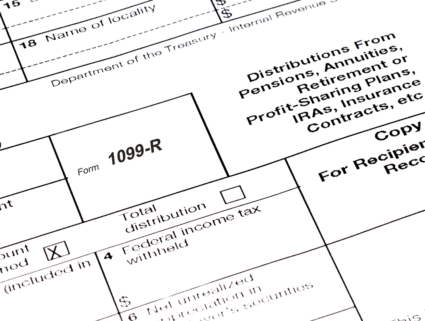Qualified Charitable Distributions (QCDs) are one of the best-kept secrets for individuals 70½ or older looking to give to charity and save on taxes. However, the total amount of your QCDs are not shown on Form 1099-R, so it’s up to you to report them correctly. Many people forget to notify their CPA of the QCDs or account for them when preparing the returns themselves, which can lead to higher taxes than necessary.
If you’ve mistakenly paid taxes on a QCD in the past, don’t worry—you can fix it!
Form 1099 Basics
Form 1099-R reports distributions from retirement accounts, like IRAs, 401(k)s, pensions, and annuities. It includes the total distribution amount (Box 1), taxable portion (Box 2a), federal tax withheld (Box 4), and a distribution code (Box 7) that indicates the type of distribution. If applicable, it also shows Roth IRA distribution taxability (Box 9b) and state tax withheld (Box 12). If you withdraw funds from one of these accounts, your financial institution will send you a 1099-R.
Why Proper Reporting Matters
Earlier this fall, we discussed Maximizing Charitable Giving with Required Minimum Distributions (RMDs). The benefit of using QCDs to reduce taxable income relies on accurate reporting to the IRS. IRA custodians are not required to track QCDs, so the responsibility falls on you to report them correctly. If not, the IRS may treat the entire distribution as taxable, increasing your income unnecessarily. Since QCDs count toward your RMD at age 73, properly reporting them can lower your Adjusted Gross Income (AGI), reducing potential Medicare premiums and taxes on Social Security benefits. Also, be sure that you maintain adequate documentation for each gift (ex. canceled check or account statement). Under IRS rules, if a gift is over $250, you must receive a written acknowledgement of your contribution from the charity indicating the name of the organization, date and amount of the contribution, and that you did not receive any goods or services as a result of your contribution. You should receive this acknowledgement prior to filing your tax return and keep a copy with your tax records.
For the DIY’ers out there: How to Report a QCD on Your Tax Return
To report a QCD, start by entering the total IRA distribution amount from Box 1 of the 1099-R on Line 4a of your Form 1040 (or Line 5a for non-IRA plans). Then, on Line 4b, report only the taxable portion of the IRA distribution. If the entire distribution qualifies as a QCD, enter $0 on Line 4b. If only part of it is a QCD, enter the remaining taxable amount. Make sure to write “QCD” next to Line 4b to indicate the exclusion.
Can You Correct a QCD Mistake from a Previous Year? Should You Amend Your Return?
If you’ve mistakenly reported a QCD as taxable income in previous years, don’t worry—you can correct it. You can file an amended return (Form 1040-X) within three years of the original filing deadline. If the mistake significantly increased your taxable income, Medicare premiums, or Social Security taxability, amending could save you money. However, if the impact was small, it may not be worth the effort. Consulting a tax professional can help you decide. A tax professional can help assess whether it’s worth making the correction based on your specific situation.
Case Study: John’s Tax Mistake
John, 75, withdrew $50,000 from his IRA in 2023, of which $10,000 was a QCD sent directly to charity. His IRA custodian issued a 1099-R showing the full $50,000 distribution without identifying the QCD. If John forgets to report the QCD, and reports the full $50,000 as taxable on Line 4b of his Form 1040, he would pay taxes on the extra $10,000 that didn’t need to be taxed. This would lead to higher income taxes, increased Medicare premiums due to a higher Adjusted Gross Income (AGI), and more of his Social Security benefits becoming taxable. However, if John properly reports $50,000 distribution, the $10,000 donation would be tax-free, reducing his AGI and overall tax burden.
Conclusion:
Since Form 1099-R doesn’t specifically track QCDs, it’s up to you to report them on your tax return. Correctly excluding QCDs from taxable income can lower your taxes, AGI, and even Medicare premiums. Grimes & Company collaborates with tax professionals who can assist with filing and help determine if it’s worth correcting past mistakes to ensure accurate QCD reporting. With your CPA and your Grimes advisor working together, you can properly manage QCDs to minimize taxes and maximize charitable giving. Don’t let a simple error cost you money!
Important Disclosures:
Please remember that past performance is no guarantee of future results. Different types of investments involve varying degrees of risk, and there can be no assurance that the future performance of any specific investment, investment strategy, or product (including the investments and/or investment strategies recommended or undertaken by Grimes & Company, Inc. [“Grimes”]), or any non-investment related content, made reference to directly or indirectly in this blog will be profitable, equal any corresponding indicated historical performance level(s), be suitable for your portfolio or individual situation, or prove successful. Due to various factors, including changing market conditions and/or applicable laws, the content may no longer be reflective of current opinions or positions. Moreover, you should not assume that any discussion or information contained in this blog serves as the receipt of, or as a substitute for, personalized investment advice from Grimes. To the extent that a reader has any questions regarding the applicability of any specific issue discussed above to his/her individual situation, he/she is encouraged to consult with the professional advisor of his/her choosing. No amount of prior experience or success should be construed that a certain level of results or satisfaction will be achieved if Grimes is engaged, or continues to be engaged, to provide investment advisory services. Grimes is neither a law firm nor a certified public accounting firm and no portion of the blog content should be construed as legal or accounting advice. A copy of the Grimes’ current written disclosure Brochure discussing our advisory services and fees is available for review upon request or at https://www.grimesco.com/form-crs-adv/. Please Note: Grimes does not make any representations or warranties as to the accuracy, timeliness, suitability, completeness, or relevance of any information prepared by any unaffiliated third party, whether linked to Grimes’ web site or blog or incorporated herein, and takes no responsibility for any such content. All such information is provided solely for convenience purposes only and all users thereof should be guided accordingly. Please Remember: If you are a Grimes client, please contact Grimes, in writing, if there are any changes in your personal/financial situation or investment objectives for the purpose of reviewing/evaluating/revising our previous recommendations and/or services, or if you would like to impose, add, or to modify any reasonable restrictions to our investment advisory services. Unless, and until, you notify us, in writing, to the contrary, we shall continue to provide services as we do currently. Please Also Remember to advise us if you have not been receiving account statements (at least quarterly) from the account custodian.



